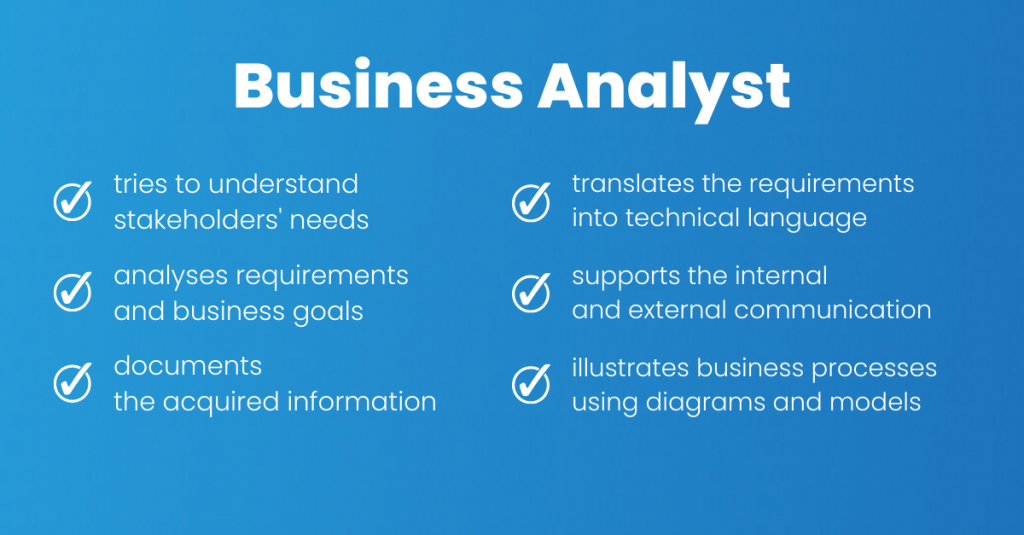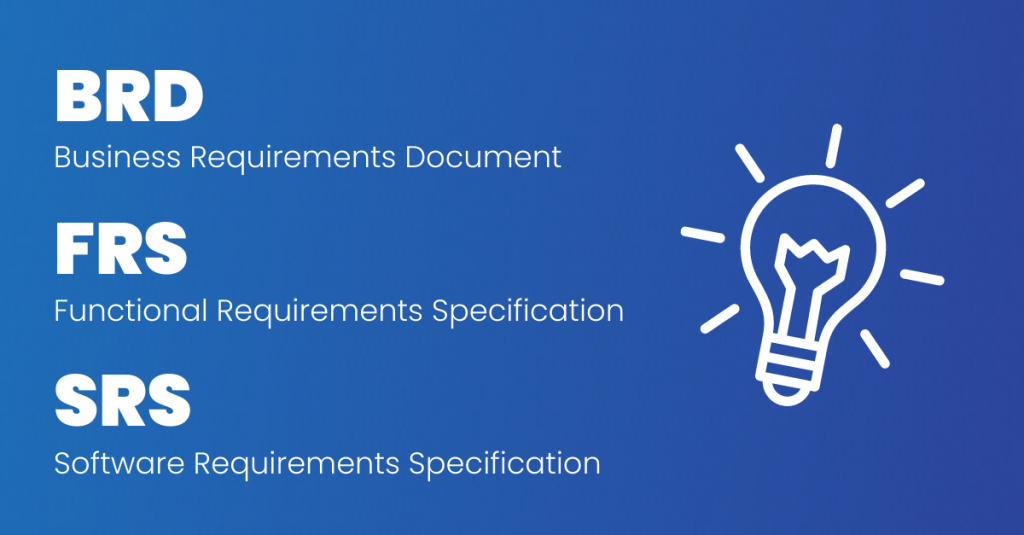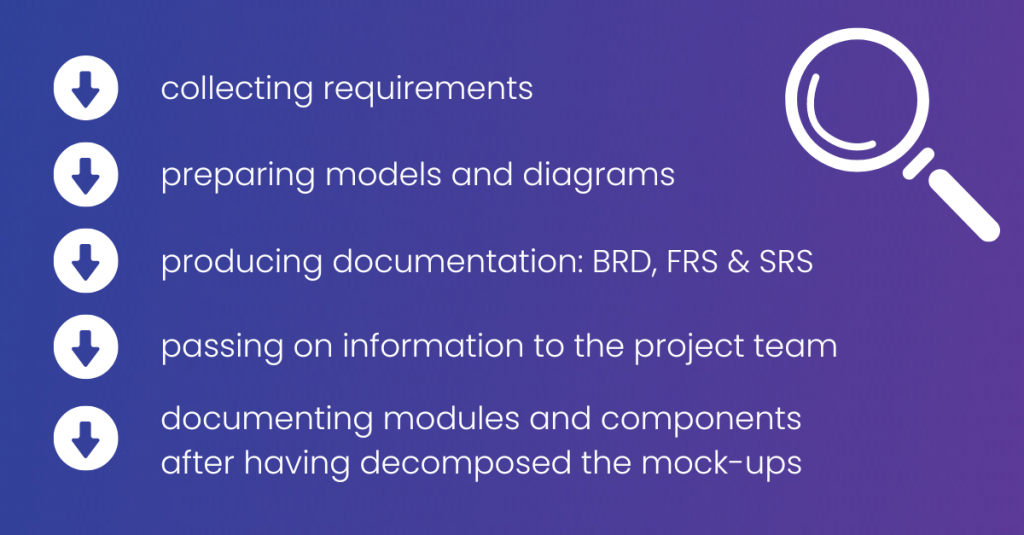Business analysis is a discipline that demands a diverse range of skills, from problem-solving and effective communication to technical thinking. To be a successful business analyst, one must possess a deep understanding of both business processes and technical systems, allowing them to identify opportunities for improvement and develop solutions that meet the needs of all stakeholders. With the ever-increasing role of technology in business, the relevance of business analytics in IT projects continues to grow, and the need for skilled professionals in this field has never been greater. At Infinity Group, we recognize the value of business analysis as a critical tool in achieving our goal of delivering high-quality products and services.
In this article, we will introduce the role of the business analyst in the project cycle and discuss their key tasks based on how our specialists work daily.
What Is Business Analysis?
Business analytics (also known as requirements engineering) is the process of collecting, analysing, and interpreting business data to understand customer needs and improve the efficiency of specific processes. The business analyst responsible for this process helps to design solutions that meet the extracted business needs. The general scope of his/her responsibilities includes:
- examining business processes, resources, objectives, and stakeholder requirements;
- proposing solutions that meet these requirements;
- translating business needs into technical language;
- supporting designers and developers in creating solutions that meet customer expectations.
What Does a Business Analyst Do?
The role of a business analyst in the project cycle is essential as they act as the link between the client and the development team. The business analyst’s responsibilities include understanding the client’s needs and objectives and having a thorough knowledge of the specific industry their company operates in. The business analyst then communicates this information effectively to the design and development team to create a product that aligns with the client’s expectations and design assumptions.
Business analytics aims to not only comprehend customer needs but also to translate them into the work of the whole team. This involves analyzing the company’s data and processes, conducting workshops to identify problems, propose solutions, and document everything in functional and non-functional requirements for the design and development team to work with.
The scope of business analytics encompasses several key responsibilities, including:
- Understanding the needs of each stakeholder by analyzing business requirements and objectives
- Identifying and optimizing business process issues
- Creating a comprehensive business requirements summary document
- Translating acquired requirements into specific user paths, business process models, assumptions and dependencies of functions and systems, as well as other types of diagrams
- Preparing functional and non-functional requirements in documentation format
- Collaborating closely with the project team
Potentially refining requirements with the client and updating documentation as needed.

Tools and Methods Used by Business Analysts
Business analysts use various analytical tools and methods to better understand the client’s business processes and project objectives and provide valuable solutions for the organisation. The list is quite long and it includes:
- Workshops with clients and users – conducted to gain information about needs, expectations and business process issues.
- Analysis of business process documents and reports – learning about the organisation’s processes and how they work.
- Analysis of business performance data and indicators – gathering information about processes and activities in the organisation.
- Business process mapping and modelling – graphically depicting business processes and understanding how they work using BPMN.
- Competitor analysis – understanding the competitive market and how competitors operate.
- Brainstorming – an applied technique for generating innovative ideas and solutions.
- Use case diagrams – showing how users interact with the system.
- User stories – a description of the role of individual users and their requirements from the system.
- Requirements analysis – a study to define the functionality and features required for a project.
- Mind maps – a graphical depiction of the various concepts and ideas involved in the project.
- Agile – a method that allows flexible adaptation to changing requirements and customer needs.
Most of these tools are primarily used at the beginning of the project cycle, during the pre-discovery, discovery, or design stage when the business analyst identifies and turns the client’s business needs into a solution design.
The Role of Documentation in Business Analysis
The business analyst plays a critical role in each phase of the software life cycle by creating and managing the requirements documentation. This documentation serves as the foundation for the entire team’s work, including UX design, development, quality assurance, and project management.
Any changes made to the documentation must be carefully analyzed for their impact on the overall product, which is another responsibility of the business analyst. As the expert in understanding the client’s needs and formulating detailed project requirements, the business analyst’s careful attention to the requirements documentation is crucial for the success of the entire project and end-user satisfaction. Therefore, the essence of the business analyst’s work is reflected in properly drafted and continuously updated documentation.
Technical Documentation in IT, or Requirements Engineering in Practice
The process of creating and maintaining technical documentation has undergone significant changes in recent years thanks to advancements in technology. In the past, every programmer was required to know how to write documentation according to accepted standards and rules. This involved working in text files sent by email and was a time-consuming task that often resulted in inadequate or outdated documentation.
However, with the development of tools like Jira and Confluence, many companies have found an easier and more efficient way to manage technical documentation. These tools enable easy task management with the creation, editing, and storage of documentation in the cloud. At Infinity Group, we use these tools daily and have found that they make the process of creating and updating technical documentation much more efficient, as everyone has easy access to the latest version of each document. To further support the drafting and updating of technical documentation, some companies have created a separate position called Technical Writer. The role of a Technical Writer includes tasks such as creating user manuals for modules that will be used by customers and providing an additional layer of support for technical documentation.
Requirements Documentation
In requirements engineering, there are three main types of documentation: BRD, FRS, and SRS, which are classified according to industry standards. The BRD, or Business Requirements Document, contains all information about business analysis, including processes, resources, key objectives, market or competitor analysis, and consumer research. On the other hand, the FRS, or Functional Requirements Specification, describes the requirements and functionality of the technical documentation. Finally, the SRS, or Software Requirements Specification, outlines the parameters that a system or application must fulfil, such as performance and security. Depending on internal project arrangements or company standards, these areas can either form separate documents or be combined into a single file. Nowadays, solutions such as Confluence are helpful tools for creating this type of documentation. They make it easy to edit entered documents and allow for ongoing updates and extensions as necessary.

Other Deliverables Produced by Business Analysts
Apart from the business requirements inventory, their prioritization, and translation into functional and system requirements, business analysts produce other documents throughout the project cycle, which are commonly known as BA deliverables. These deliverables vary depending on the stage of the project and can be seen as tools for the business analyst’s work, as discussed previously.
Scope of work for a Business Analyst in a Kentico DXP Implementation Project
To showcase the scope of a business analyst’s work, let’s take a look at their next tasks in a sample project cycle at Infinity Group, where we specialize in designing and implementing websites using DXP (Digital Experience Platform) solutions, such as Kentico.
Suppose a client approaches us to create an online shop for their company that is transparent, user-friendly, and easy to manage. The client also wants to integrate various functionalities, such as a calculator, and contact forms, and integration with other systems, like a specific payment system. Furthermore, they want to personalize content and use digital marketing functionalities to better cater to shoppers’ needs.
The business analyst would start by conducting interviews with the Project Manager and stakeholders on the client side to obtain all requirements related to website functionality, design, behaviour, security, and performance. They would then transform these requirements into models and diagrams that represent the processes and user paths graphically and in a way that is understandable by the project team. For example, they may create BPMN models to depict the business processes that would take place during the use of the new website, diagrams showing the dependencies of the systems to be integrated, and tabulated User Stories. These documents collectively form the Business Requirements Document (BRD).
The next step involves preparing requirements documentation that contains detailed descriptions of each required functionality, how they would work, and how they would be tested. This includes the Functional Requirements Specification Document (FRS) and the Software Requirements Specification Document (SRS). These documents are created in parallel with the graphic designs to provide the broadest possible reference point for developers. At this stage, the information gathered is also passed on to UX/UI designers who create mock-ups of the website. The business analyst would then document the individual modules and components by decomposing the mock-ups and marking the functional and non-functional requirements.

Once this work is completed, and stakeholder compliance is confirmed, the production phase begins, which involves the work of developers, followed by iterative testing by the QA team (testers) on new environments to ensure that the product meets all requirements and performs according to stakeholder expectations. During these stages, the business analyst would observe the workflow and support the team’s communication, both internally and with the client.
The business analyst’s work was instrumental in ensuring that the project team understands the client’s requirements and will create a Kentico website that meets all the expectations. In addition, the analyst is responsible for updating their knowledge of the client’s requirements and needs and suggesting possible improvements when maintenance and development work is decided upon.
Challenges in Business Analysis
Business analysts face various challenges throughout the project cycle. One of the most significant challenges is expanding the scope of a project, as every change in the project’s scope affects lead times and costs, requiring new research, analysis, and verification. To tackle this challenge, business analysts must employ appropriate techniques, such as agile approaches, that allow for flexible responses to project changes.
Another challenge that business analysts frequently encounter is managing conflicts between stakeholders who often have different goals and expectations for the project. To address this issue, business analysts must understand the diverse requirements accurately and work out a compromise with the parties to establish a coherent direction for the project. Effective communication with the implementation team is also a critical factor in the success of a project. Business analysts must communicate project requirements effectively to other team members, such as developers and testers, to ensure the project’s consistent and correct implementation.
The Value of Business Analysis for an IT Project
Business analysis plays a crucial role in ensuring the success of an IT project. By improving the quality of the end product, increasing its performance and enhancing stakeholder satisfaction, it has become an essential process in the project lifecycle.
The business analyst is responsible for establishing project goals, requirements and constraints at the outset, and then gathering, documenting and analyzing all requirements during the discovery process. In the design phase, the analyst creates models and documentation of the requirements, and in the implementation phase, they decompose modules, refine technical documentation, and coordinate the project team. Continuous communication and proper requirements management are key components of successful project implementation, and the business analyst is critical to ensuring this. The analyst must remain aware of challenges, such as ambiguity and variability in requirements or lack of stakeholder involvement, and must address them through effective communication and management techniques. At Infinity Group, we understand the value of business analysis and provide comprehensive support from our team of expert analysts at every stage of the project, ensuring the best possible outcome for our clients.
The Future of Business Analysis
Business analytics is evolving with advances in technology, such as the growing interest in DXP-class solutions. As organizations seek digital transformation, the demand for skilled business analysts who specialize in new technologies will continue to grow. The role of business analysts is also shifting towards more strategic and developmental thinking, where they are expected to proactively identify opportunities and propose innovative changes. As data becomes more central to business decision-making, the ability to analyze and interpret it will become an even more valued skill in the profession.
Summary
The ever-changing digital landscape and the need for continuous development and innovation have made the role of business analytics increasingly important. Business analysts are in high demand as they bridge the gap between business and technology. Their contributions are critical to the overall success of a project, and continuous development is essential for anyone interested in this field. With the right attitude and commitment to expanding their skills, business analysts can make a significant impact on the development of a specific project and the entire organization.
Information sources:
- A Guide to the Business Analysis Body of Knowledge® (BABOK® Guide) International Institute of Business Analysis (IIBA);
- IREB – International Requirements Engineering Board Syllabus;
- Requirements Engineering in Practice. Bartosz Chrabski, Karolina Zmitrowicz;
- Business Analysis for Practitioners: A Practice Guide. Project Management Institute (PMI).
